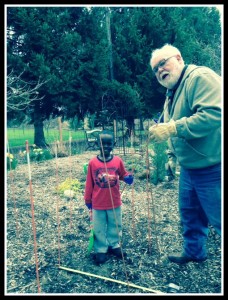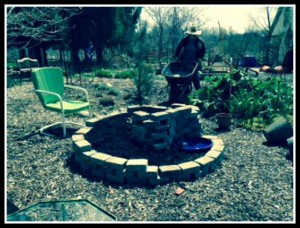On Sunday, May 4, we built an herb spiral in Serendipity Gardens. Altogether, it took about five hours, but we rested between hauling wheelbarrows full of edging pavers to the site of the spiral. Other than that lifting and hauling chore, it was an easy project.
 Here is what the finished product looks like, pre-planting. This view is from the top. The spiral is five feet in diameter. At the bottom, the dirt is two pavers high. We added a row of pavers every three and a half pavers. At the top, the spiral is seven pavers high. The soil stays level with the pavers by sloping up from the bottom row to the top.
Here is what the finished product looks like, pre-planting. This view is from the top. The spiral is five feet in diameter. At the bottom, the dirt is two pavers high. We added a row of pavers every three and a half pavers. At the top, the spiral is seven pavers high. The soil stays level with the pavers by sloping up from the bottom row to the top.
If you Google “Spiral Herb Gardens,” you will find hundreds of images depicting many styles of this type of garden. We did not follow any particular photo, but we did read directions. If, after reading this post, you decide you want to build an herb spiral, too, you can easily find directions online.
Our spiral includes a blue bowl that will eventually become a small water feature, once I find the stones I want to put in the bottom of it. We already had the bowl. We purchased it with the idea in mind of making an attraction for butterflies with wet sand, but we did not have much success. In fact, the bowl eventually got buried to the lip and became nearly invisible. This will be a much better use that shows off the bowl’s beauty. The bowl also explains the spiral’s somewhat odd shape, as we indented the pavers to accomodate its curve. The bowl is mounted on the bottom level of pavers, and it has a hollow space underneath it where we hope a toad might find a good home.
“A snake might like it, too,” says my husband. I am rooting for the toad, but Serendipity Gardens is, after all, a working ecosystem!
Benefits of a Spiral Herb Garden
An herb spiral exhibits many of the principles of permaculture and it offers several permaculture-related benefits. It makes use of the natural force of gravity, allowing water to drain freely and seep down through all layers – leaving it drier at the top (perfect for hardy herbs) and a moist area at the bottom for those that love water. This creates microclimates (sunny, sheltered, shady), which makes it possible to plant a diverse range of herbs in a single location. The pavers in our case (or other stones, rocks, bricks or blocks) that are in the spiral walls absorb the sun’s heat during the day and release it at night, keeping the soil warm when temperatures drop.
According to The Microgardener website, which provides excellent photos and a more detailed lists of benefits, here are a few good reasons to build and plant an herb spiral. You can:
- Have a beautiful garden feature.
- Smell the lovely fragrances of the herbs.
- Grow more food in less space. (The mounded spiral ramp maximizes the surface area for planting. Your herb spiral can be as small as three feet in diameter and still grow a substantial amount.)
- Grow healthier plants. The various microclimates enable you to meet their growing needs.
- Manage the water needs of the plants efficiently by watering from the top and letting the water drain down through the spiral.
- Attract beneficial insects by interplanting the herbs with companions such as borage, calendula, French marigolds, and nasturtiums.
- Build habitat. If you get lucky, a frog or toad might locate in or near the spiral and help keep the numbers of harmful pests down.
- Get all this on the cheap. If you make your own compost, the cost of the filler is nothing. If you have leftover bricks or pavers as we did, the cost of the walls is minimal, too.
A Family Project
 We began our herb spiral with the help of one of our grandchildren. His job was to hand his grandpa the sticks he was using to mark the dimensions of the spiral. He was very helpful. Older children could easily lay the pavers, help add and smooth out the dirt and compost, and eventually plant the spiral and harvest the herbs.
We began our herb spiral with the help of one of our grandchildren. His job was to hand his grandpa the sticks he was using to mark the dimensions of the spiral. He was very helpful. Older children could easily lay the pavers, help add and smooth out the dirt and compost, and eventually plant the spiral and harvest the herbs.
Building an herb spiral would also make a great project for a school. It would offer tremendous opportunities for learning about meeting the needs of plants in an efficient and sustainable way.
We debated a bit about the location of the spiral. The place we finally chose is reasonably close to the kitchen, so walking out to snip off a bit of an herb will be easy. It also gets sun from one angle or another through most of the day, which is perhaps the most important consideration. And it’s close to the swing where we often sit, so we can watch what is happening.
The most difficult aspect of our project was wheeling the pavers from where they were stacked behind our barn into the garden and over to the spiral site. This trip involves opening and closing a gate and maneuvering the wheelbarrow across a small bridge and along a garden pathway. To make it less heavy, we only loaded about 25 pavers at a time. This necessitated making six to seven trips.
Here are a couple of photos that show our progress:
What to Plant
An herb spiral has several levels (see photos for where the pavers step up a notch). We will start at the top on level 4 and plant rosemary, thyme, sage, and lavender. On level 3, we’ll plant oregano, tarragon, and cilantro. On level 2, we’ll add basil and parsley. Finally, on level 1, we’ll put in things like pennyroyal, chamomile, and calendula. We also plan to insert small plants into the holes in the wall where we can. Look for another post later in the summer after the herbs are established and growing.
You don’t, of course, have to plant only herbs. Whatever garden plants need the microclimate of a particular part of the spiral could go there.
Like this post? Sign up to receive an email each time a new post is available. We will never loan, sell or rent your email address — that’s a promise! Please use the buttons below to share with others.


Nice project, only 6 hours to copmplete!
Jo Ellen, thank you so much for this lovely post! It’s raining here to day – and we need it in Southern California – but your post has me itching to get outside and dig in the dirt! Can’t wait to hear about your herb garden as it thrives.
Love this idea–and the photos!